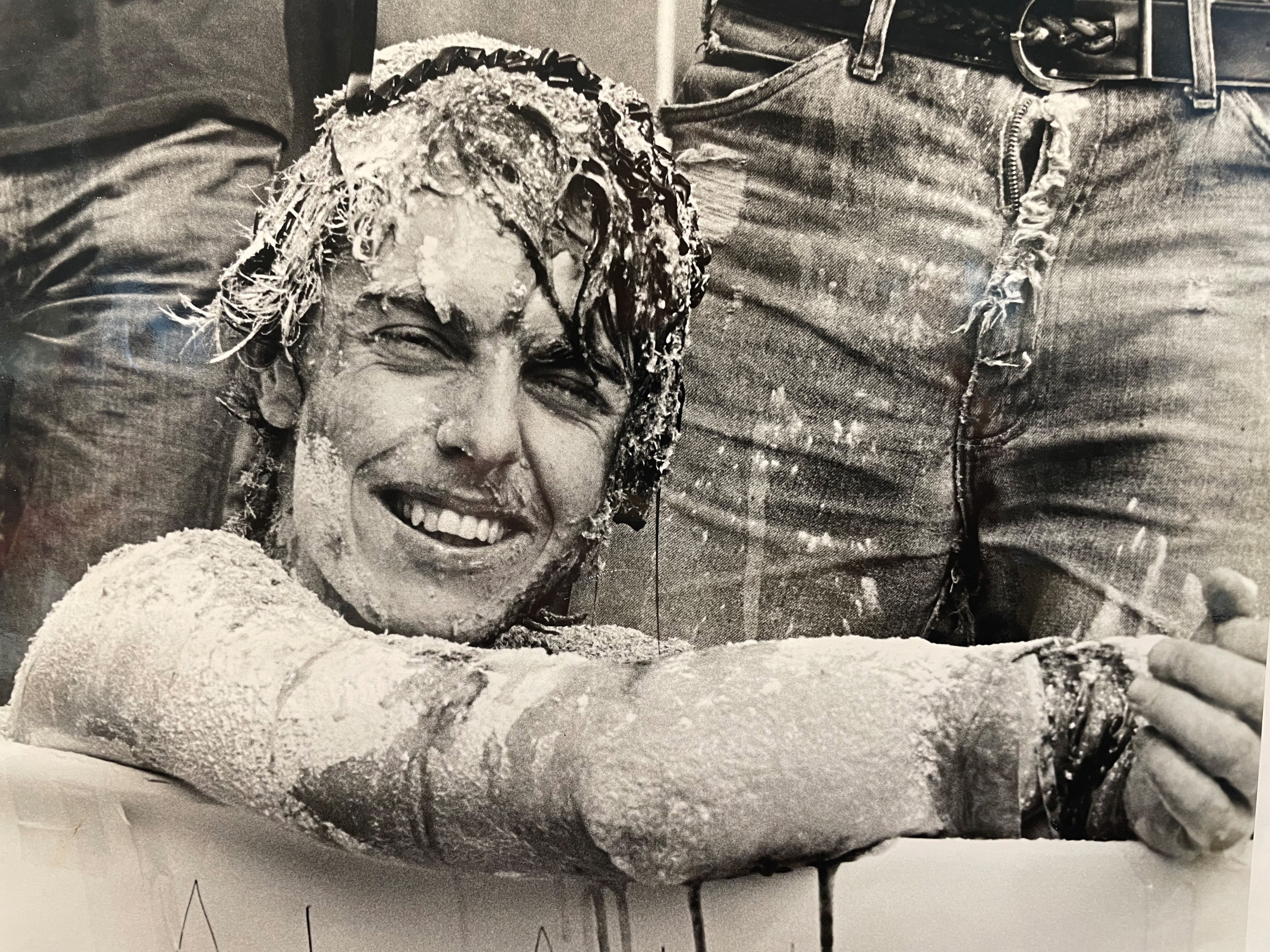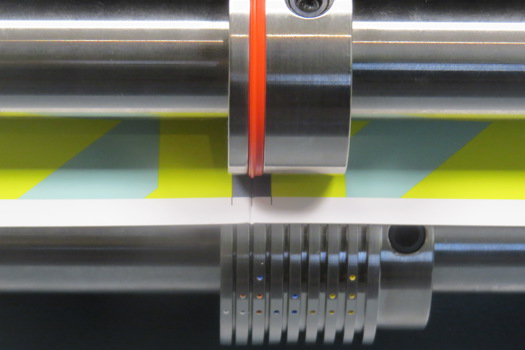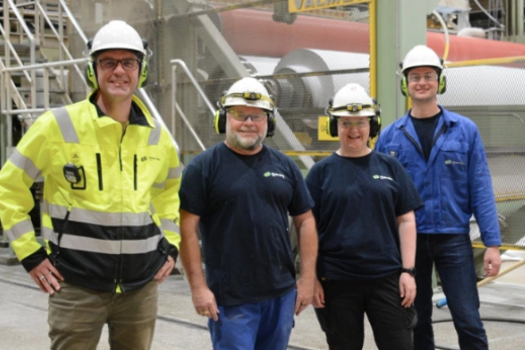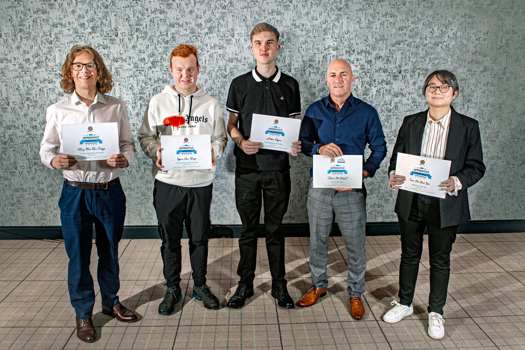Jo Francis: You started off as an apprentice, how did you get the placement?
Alan Wright: I had uncles and cousins in the industry, and I was thinking about what I was going to do when I left school. And I think my dad was obviously doing his bit, reaching out to family. And I remember my uncle said to my dad that Alan would be wise to go into repro. This was in 1976.
It was a beautiful summer, and I was lucky enough to track down a company in Slough, which is where I grew up. It was a start-up, repro company called Monographics started by a guy called Brian Thompson.
Brian Thompson had, at that time, two other fairly sizable, extremely high-quality repro companies called Culver Graphics in a sleepy little village in High Wycombe called Lane End, and JT Graphics which was in Chiswick.
Brian was a very lovely, lovely guy. I remember going for my job interview, my first ever job interview, and applying for an apprenticeship. And then getting a letter that said “you're coming for a week's trial”. And it was me and another boy. By the Wednesday, Brian has said I'm going to give both of you a bit of test. And what does that look like? Well see that office. You're going to go in there and your task is to decorate the office. And I kid you not, that was it. So, there I was with emulsion and a tin of gloss in hand.
No way! Imagine that happening now.
And we get to the Friday and the judging jury, the best decorator won and I got the job.
Your neat edges did the trick?
My cutting in at the time I was on point and that was it, I got the job. And that was to become a proper indentured apprentice. My parents were called up to sign my indentures with Brian and my then manager, George Bourne. I was an apprentice, an apprentice repro lithographer. So, I was then part of Monographics and my job started.
And what sort of equipment was being used at that point?
Pre-sensitised plates had just come in. Gallery cameras. Colour separations produced from cameras, not anything else. Just think film. So very raw in that sense. But it was great, and I remember loving it. I couldn't have been happier. I used to cycle to work. It was fantastic.
How many years was the apprenticeship?
It was a four-year term. And I was assigned to go to college, the London College of Printing in Back Hill in London and I used to do day and night release.
What was Brian Thompson like?
He was a brilliant man who without question could have dominated the then repro industry. It was Brian's other love of music – he was a jazz musician, often appearing at top international jazz clubs, Ronnie Scott’s included, that prevented him from doing so. Brian knew the importance of work/life balance even then!
What happened next?
I was not the best-behaved apprentice. Half-way through my apprenticeship I had a ‘romance’ with a fellow female studio colleague who was 10 years my senior – it did not go down well with Brian, so I was banished to Culver Graphics to finish my apprenticeship and get properly banged out – where I ended up in the village pond. It was while I was at Culver that I met Gerry Bett (sales), and latterly Stan Dorme (studio) who ran JT Graphics, because as part of my apprenticeship I spent a few weeks at JT to broaden my knowledge. I couldn't have wished for a better apprenticeship. It really was fantastic.
Despite being banished, the stars must have been in alignment then for you to meet Gerry and Stan at that point.
Yes. In 1980, which was also at the time of me finishing my apprenticeship, Stan and Gerry left the Culver group to start Magnet Litho. Gerry knew me as a cocky young apprentice and he asked if I'd like to go and join the start-up. This would have been around about ‘81 and I got cold feet. I said no, I didn't quite do it. But thankfully he asked again.
Phew!
At this point in ‘82, I took the plunge, left my job at Culver and joined Magnet. It was a huge leap of faith. We did nice work. It was all going well. And within a year it was going very, very well. And I then just morphed into production. I started getting into production and it was flying, absolutely flying. We grew from 1982 to 1985. We grew from about five people to about 25 people.
Those must have been great times.
My job was to recruit and build a team. There was an easy route to that. So, I would pick the phone up and ring my old journeymen. And if you paid the rate and offered a shiny gold GTI on top of that, it normally did the trick! They were all great, highly talented hires. And by late ‘84, we were bursting at the seams as we needed to move. We were able to luckily buy a freehold place, in Packet Boat Lane in Uxbridge, which is still one of our sites today. We moved in on May Day 85. I Remember it so well. And it was like an aircraft hangar compared to what we'd come out of. And we thought, well, we've got to kit this out. And repro at that point had moved on. Scanners had come into play, and we added new technology in the form of a Cadograph mask cutting system and proofing presses. So, we managed to cut a very sizeable deal with Dainippon Screen. You might remember a guy called Brian Forsdike?
Indeed I do.
We spent an awful lot of money, thankfully we were always very well run financially and managed to save a lot of money as well. But we spent a lot of money kitting out our shiny new site, which moved us up a notch in the repro league table. And we kept on growing. I'm running production, and Gerry was getting the sales, he was a great salesman.
What a buzz to be part of a growing, successful business.
I'd only been with the company about a year when I was given the opportunity to buy in, and at the time I did not really know too much about what that even meant. But I trusted Gerry implicitly and I remember at the time taking out a mortgage bigger than my then mortgage, but just going for it. And over the ensuing three years, I increased my shareholding and by probably ’87-’88, I'd acquired 31% of the business and that remained the case.
It's striking that so early in your career you had that ambition, that confidence.
Yes, that go for it mentality but with, I guess, that assurance and trust and belief of Gerry, who was obviously my senior. So, there was always that sort of mentoring.
I was going to say that he was a really good mentor by the sounds of it?
I have everything to thank Gerry for. Brian Thompson in my early, early stage was hugely influential. Gerry of course, for the next period, which was from 1982 to 2002. We're in Packet Boat Lane at this point and need to turn the dial up again. And this is all pre-Mac. We had to then think, are we going to get into the big boys’ league? And we'd already said yes, we would. And getting on to mid-’80s you had four key manufacturers to choose from: Crosfield, Hell, Dainippon Screen, and Scitex. And we saw them all. And Scitex was the one back then, it also just happened to be the most expensive! But it did do it for us because we were just smitten with the technology. It had beautiful intelligence built into that, inasmuch as we had a plotter called a Raystar, which could scan artwork and it could also output film. We probably spent a year researching the market and we committed to Scitex, and I remember going to Brussels and doing a deal with Stuart Macer.
Another famous name from the halcyon days of repro. That proprietary kit at that time was really something. And really expensive.
Yes, it was! We moved up a notch. It's all going on in the repro industry. And we're in the club, an elite club of high-end users. And I should mention, we were very fortunate in the work type that we were involved with. We were not into mass page production. We were into fine art, report and accounts, working with lovely printers, doing lots of lovely work that needed and required high end reprographics. And that was us through and through. And we gained our relationships and our reputation. And then all of a sudden, this thing crops up over the horizon called a Mac.
And print was never the same again.
By that time, we’d probably got, I don't know, 40 or 50 planners working for us and knowing full well that it's going to be such a huge impact in that space. But we had no choice. We had to embrace the technology and we were already doing that anyway. And we started to bring in interface technology that saw our systems interface with Macs. And probably over the next three- to five-year period almost transitioned 60%-70% of our planners onto systems. The ‘90s were also, I think, a really dramatic period of change for us because not only did that decade see the transition in page production, artwork, repro, etc, it also bought with it changes in how you captured imagery. Because digital photography came into play and we knew unless we got into that, we would never be able to command and control an image.
That was a very smart realisation.
Looking back, we've always had a good feel for tech and future trends and what's coming. And we were genuinely one of the earliest players in digital photography. The first digital camera backs we had; the flash used to go three times so you couldn't shoot a glass of champagne! But we still went for it. And we learned on the job, and that was an interesting move for us. And of course, that was the death knell for scanners. But if that wasn't enough at the time, alongside that, something called digital printing started to bubble up as well. And that was an interesting one for us, because Gerry had originally come from a print background and was quite curious about this technology, and we were full of confidence at the time.
The promise of digital print technology was incredible back then, but at that point it really was the bleeding edge of technology – it just didn’t necessarily quite work yet.
I think certainly with digital print we were trialling, but we got on with it. And to this day, we have Xerox digital printing kit, which I guess says something. They've always supported us. We've seen massive changes technology wise, this whole collision of technologies in the 90s, an unbelievable decade.
And the business was growing in other ways, as well?
Yes. We also made quite a few acquisitions and we'd acquired a packaging company in the mid-90s, a company called DAS – Digital Artwork Systems. We liked them very much because that was part of our realisation that repro was going to be changing and printers were going to be putting CTP in. We thought, okay, let's look at other areas that we felt were areas that we already had exposure in, but not much exposure. And DAS were a true innovator of a concept called DAR – digital artwork and repro. And they had a Purup system at the time, and that was a very important tactical move for us, when I look back. Packaging pre-media at the time was almost exclusively produced in the north of England – I was determined to change that.
We also ended up buying what were then some competitors of ours. We bought a company called Richmond Repro and we named that company Harlequin. And then we put the two together. That's how we got to Magnet Harlequin.
Ah-ha! The origins of Magnet Harlequin, I hadn’t realised that.
And then we bought a lovely repro company called Valhaven and then another acquisition in Oxford. So, the ‘90s also saw quite a bit of activity on the acquisition trail. And all of that was buoying the company and building the company. And we'd had a couple of nibbles and interest in our business along the way too.
The acquisitive Magnet Harlequin could have been acquired?
In 2002, out the blue, I get a call from a consultant who said we'd like to have a chat with you. It turned out to be for Scandinavia's largest marketing services group, and they’d identified Magnet Harlequin as a target. However, after six months of due diligence, and boy oh boy were there some interesting stories in that, the deal fell through at the last.
How disappointing. But I suppose on the bright side at least it wasn’t Wace.
They had approached us too! However, when the Scandinavian deal didn’t happen, Gerry said look, all good Boy Scouts need a plan B. So, we did have a plan B. Gerry had actually made it reasonably clear that he was ready to go and wanted to step down and effectively retire. And at that point, I'm still young, we then had an MBO and that was the start of a new chapter. Gerry sailed off into the sunset, literally on his very nice boat, and we marched on, myself and four of my then co-directors. It was a new start.
And after that, along comes Writtle?
We get to 2005 I got another one of those phone calls, we’d like to have a chat with you. It was a gentleman called Patrick Bell who at that time was Robert's [Robert Essex, Writtle Holdings chairman] number two, a very enigmatic, charming chap. Patrick then says, I'll come clean. The reason why I've asked for chat is that is that we've got an idea. We've formed a new marketing services group called Writtle. We've got two companies already and we quite like pre-press as an area to bring into the other companies.
And probably within six weeks, we agreed to sell a minority state. By this point we'd met Robert and I was instantly charmed. I got on with Robert and I knew straight away that this is really interesting. If there was one thing I felt at that time, having already had the journey that I'd had, it was that we needed someone of this higher strata, and we all said yes to it.
It seems to have worked out very nicely all round.
It really was the main catalyst for change. So, a huge moment which then saw us become part of a start-up group. As Writtle started to grow and we started to benefit from that quiet experience and intellect that came into the business, it was fantastic. It gave us the confidence, really, to go out and do what we wanted to do – we hired tech specialists and created MagLabs as a business. That was a huge move for us. We were given confidence then to look at look at acquisitions, which resulted in us buying Technik, a company I’d admired for years. The business was really forming and coming together, and we had this real vision and desire under Writtle to grow further and build out an end-to-end our own little mini agency group. And that happened.
And this has all culminated in the recent consolidation of capabilities, under the Branded umbrella. I guess it was the perfect time to bow out – and you’d also put in place your own succession plans with the appointment of Jamie Richards as Branded CEO last year?
There's a natural crossroads. I brought Jamie into the business, and I've mentored Jamie for that time and he was made a CEO a year ago. It was always the whole plan that Jamie was going to be my successor and I probably knew that very early on.
The business could not be in better hands, and I thought, it all feels right, the timing is right. We've had everything lined up, the rebrand, the restructure, and that has all happened. And it’s all coincided with our annual team meetings. So, I've had an opportunity to go around to each of our sites and when I said my closing notes, I gave my thank yous to everybody, from the heart. I love this industry, I really do. It's been great for me. I think about those people on my journey that I look back on with such affection and gratitude. Brian Thompson, Gerry Bett and Robert Essex. I've had three guys shape my career, but it began with Brian, and it was Gerry Bett who gave me my big break and I'll forever be in his debt.
Enjoy your retirement, Alan. You deserve it!
I've loved every minute. Repro is special and I came into it at such a magical and electrifying time – the characters both at production businesses and suppliers, many of whom I was fortunate enough to meet, were all like-minded. What a ride.
 TIMELINE OF NEARLY 50 YEARS IN PRINT
TIMELINE OF NEARLY 50 YEARS IN PRINT
- 1976 Begins four-year apprenticeship at Monographics in Slough
- 1982 Joins Gerry Bett at Magnet Litho
- 1983 Takes up opportunity to buy into the business
- 1987 Major technology investment in Scitex systems propels Magnet Litho into further high-end work and packaging
- 1990 Magnet acquires Richmond Repro and rebrands it as Harlequin Repro
- 1993 Merges with Harlequin and becomes Magnet Harlequin
- 1994-96 Investment in both digital photography (Leaf) and digital printing (Xerox-badged Xeikon)
- 1996 Acquires packaging pre-press specialist Digital Artwork Systems (DAS)
- 1999 Buys Valhaven Repro
- 2002 A takeover bid for Magnet Harlequin by Citat, at the time Scandinavia’s largest marketing services group, falls through. “Plan B” was an MBO that saw Gerry Bett retire and Wright stay on with a newly formed board
- 2006 Magnet Harlequin becomes part of Writtle Holdings, “which we are proudly part of today”
- 2008 Launch of MagLabs
- 2009 Writtle takes majority stake, Wright joins its board
- 2011 Opens first Asia studio in Hong Kong. India follows
- 2013 Acquires Technik – “Terry Walker’s company, which I had admired for years”
- 2019 Launch of Branded version one, a collective offering from companies in the Magnet Harlequin group
- 2023 Launch of Branded version two and the end of an era for the Magnet Harlequin and Technik brands, which are retired. Also, the end of an era for Wright, who retires as executive chairman of Branded but remains on the Writtle board









